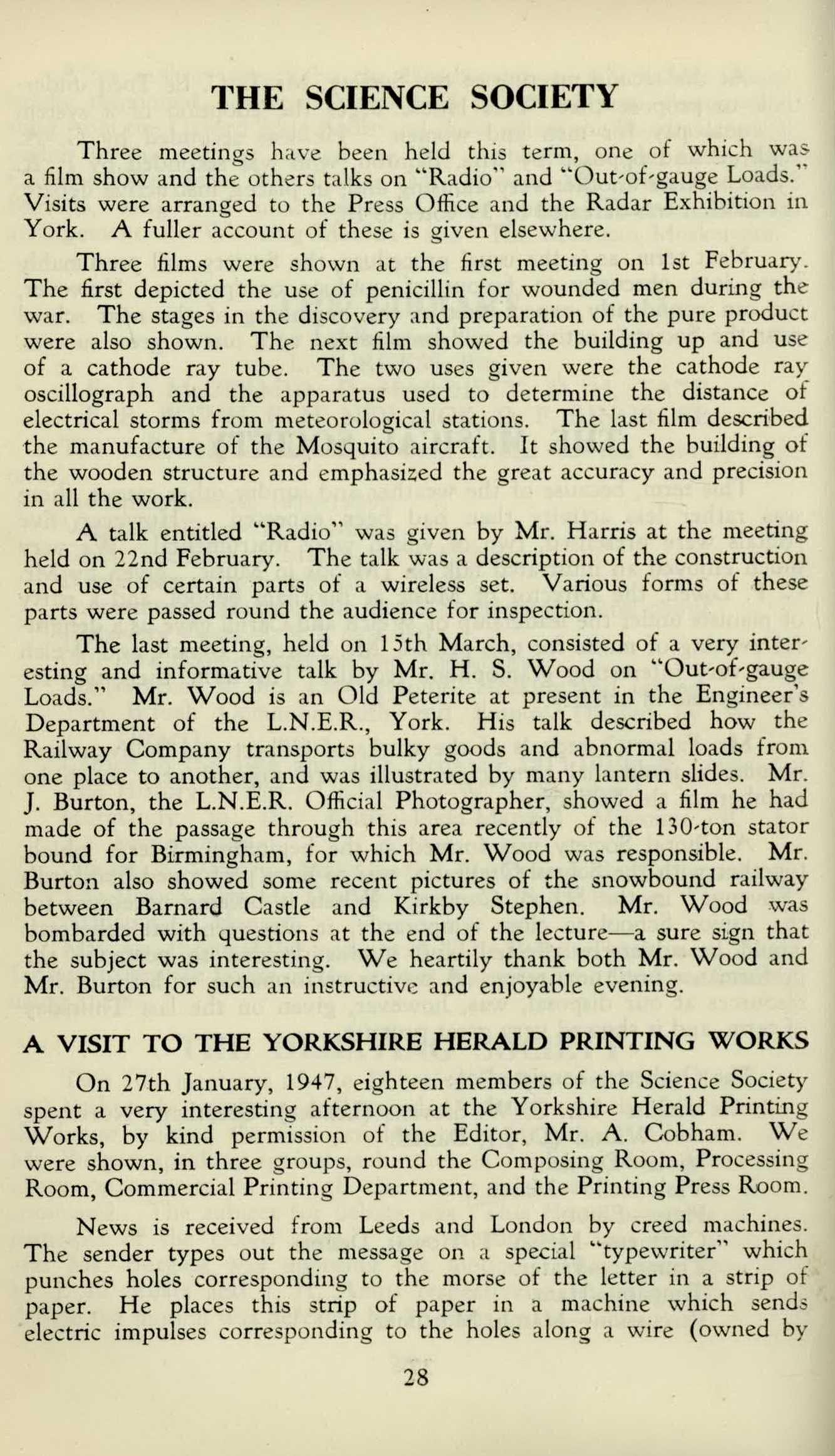
12 minute read
The Science Society
from May 1947
by StPetersYork
Three meetings have been held this term, one of which was a film show and the others talks on "Radio" and "Out-of-gauge Loads." Visits were arranged to the Press Office and the Radar Exhibition in York. A fuller account of these is given elsewhere.
Three films were shown at the first meeting on 1st February. The first depicted the use of penicillin for wounded men during the war. The stages in the discovery and preparation of the pure product were also shown. The next film showed the building up and use of a cathode ray tube. The two uses given were the cathode ray oscillograph and the apparatus used to determine the distance of electrical storms from meteorological stations. The last film described the manufacture of the Mosquito aircraft. It showed the building of the wooden structure and emphasized the great accuracy and precision in all the work.
A talk entitled "Radio" was given by Mr. Harris at the meeting held on 22nd February. The talk was a description of the construction and use of certain parts of a wireless set. Various forms of these parts were passed round the audience for inspection.
The last meeting, held on 13th March, consisted of a very interesting and informative talk by Mr. H. S. Wood on "Out-of-gauge Loads." Mr. Wood is an Old Peterite at present in the Engineer's Department of the L.N.E.R., York. His talk described how the Railway Company transports bulky goods and abnormal loads from one place to another, and was illustrated by many lantern slides. Mr. J. Burton, the L.N.E.R. Official Photographer, showed a film he had made of the passage through this area recently of the 130-ton stator bound for Birmingham, for which Mr. Wood was responsible. Mr. Burton also showed some recent pictures of the snowbound railway between Barnard Castle and Kirkby Stephen. Mr. Wood was bombarded with questions at the end of the lecture—a sure sign that the subject was interesting. We heartily thank both Mr. Wood and Mr. Burton for such an instructive and enjoyable evening.
A VISIT TO THE YORKSHIRE HERALD PRINTING WORKS
On 27th January, 1947, eighteen members of the Science Society spent a very interesting afternoon at the Yorkshire Herald Printing Works, by kind permission of the Editor, Mr. A. Cobham. We were shown, in three groups, round the Composing Room, Processing Room, Commercial Printing Department, and the Printing Press Room.
News is received from Leeds and London by creed machines. The sender types out the message on a special "typewriter" which punches holes corresponding to the morse of the letter in a strip of paper. He places this strip of paper in a machine which sends electric impulses corresponding to the holes along a wire (owned by 28
the company) to York. Here the impulses cause a machine to punch corresponding holes in another strip of paper. This is fed into a fourth machine which translates the holes back into words. This news, together with items and articles which are received from local reporters and correspondents, is passed to the editor's offices, whence they are sent to the Composing Room. Here, lines of type (which are made from a tnetal consisting of lead, tin and antimony) are made by "Linotype" machines. At each machine an operator types on a keyboard, and as he taps out the story, matrices of the letters rattle into place until a line is completed. The molten metal is then automatically poured in the matrices and a cast of the complete line in type-metal is made. After casting, an arm on the Linotype comes down and takes the matrices to the top of the machine, where a screw pushes them along to their respective compartments. Here they are deposited as the ends of the matrices are cut in a special way so that this happens. Line after line is cast until there is a whole article.
Photographs are dealt with in the Processing Room. Here they are developed and printed, and the prints are photographed by a special camera on to a photographic plate placed behind a screen of wire netting with a mesh of 65 lines to the inch, forming a glass negative. The camera does not point at the photographs, but at right angles to them, the light being reflected into it by a total reflecting prism. The purpose of the screen is to break up the picture into fine dots in order to produce gradations in the final reproduction. The light provided for this camera is from two carbon arc lamps. A zinc plate, sensitised with a yellow film containing fish glue and potassium bichromate, is exposed behind the glass negative to the light from a carbon arc lamp for about ten minutes. The action of the light makes the parts corresponding to the dark parts of the original photograph resistant to the subsequent action of the acid. The yellow sensitised surface is least affected on those parts corresponding with the light parts of the photograph. This yellow film is washed off under a cold water tap and the plate is then put in a machine in which an electric motor drives paddles that splash weak nitric acid on it, thus eating away the non-resistant part of the plate, leaving the other part standing out in relief. The plate is then heated. over a gas ring.
In the the Composing Room the type and photographs are fixed tightly into a metal frame known as a "forme." With a sheet of papier mache called a "flong," it is then put in a hydraulic press which, with a force of 680 tons weight, impresses the flong. Strips of cardboard are placed on any large spaces left for late news. After being in the hydraulic press, the flong acts as a mould for the next process, which consists of forcing molten type-metal against the flong to form a semi-circular block for the printing press. This is rapidly trimmed in another machine and the trimmings thrown on to moving rollers which take them back into the melting pot. 29
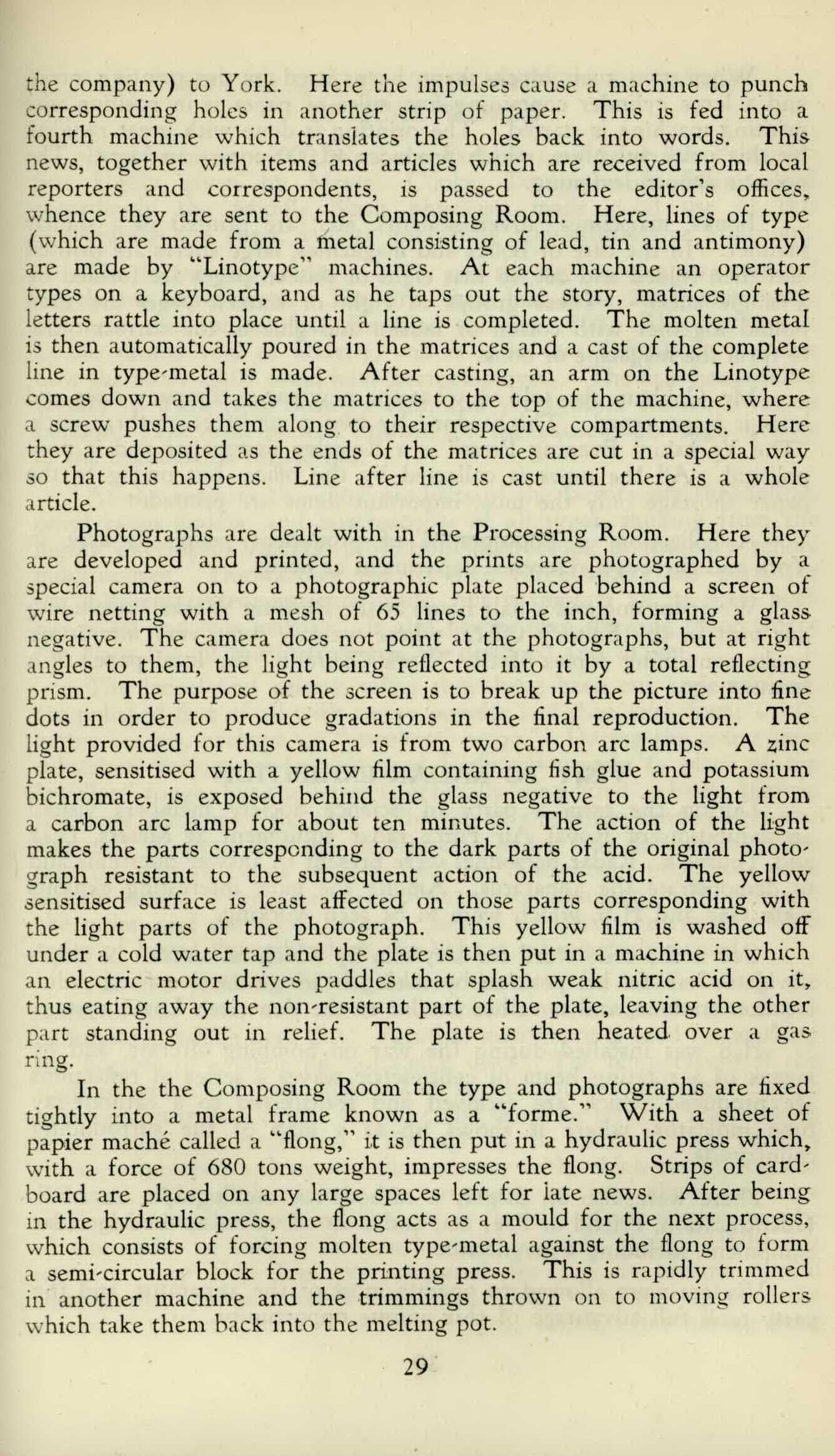
When two such blocks have been fitted in the printing press, and a large cylinder containing five miles of paper is in position, the printing machine is started. The printing is done with great rapidity by this powerful press, which produces 40,000 copies an hour. The noise is almost deafening.
Books, magazines, advertisements, etc., are printed in a similar manner. In the case of books and magazines, large sheets are printed and then folded and cut, so that eight or sixteen pages are formed by a single sheet. These groups of eight or sixteen pages are then bound together with cotton or muslin and glue in the correct order to form the magazine or book.
Mr. Cobham also told us what the newspaper company does and how it is governed. This is done by two committees of three each. "The Yorkshire Evening Press" is a Kemsley newspaper and is nonpolitical. All the news is collected by the office, but owing to the paper shortage only the most important items are printed.
A collection of photographs of prominent people is kept in York and there is a reference department at Leeds.
We spent one and a half hours at the Printing Works, concluding our visit in the Editor's Office, where we saw some very interesting books containing copies of the "York Courant," the local paper of a century ago.
VISIT TO RADAR EXHIBITION
During the term a party of Science Society members visited an exhibition of Royal Air Force radar equipment at Messrs. Leak and Thorpe's. Radar personnel were present to answer questions and to demonstrate the apparatus. Among the most interesting exhibits were Gee and I-1 2 S, which were to be seen working.
Gee is the code word for a system by which an aircraft or ship's navigator can fix his position by taking bearings on two fixed radiolocation stations, and is rather similar to the American Loran system. 11 2 S was installed during the war on bombing aircraft, and by means of a rotating beam of centimetric waves a series of reflections are produced which are received and transferred to a cathode-ray tube indicator, where it shows up as a map of the surrounding countryside.
There were also on display a cathode-ray oscillograph, an I.F.F. (Identification, Friend or Foe) set, and a set of valves as used in radar equipment, including a magnetron.
Visitors were allowed to operate most of the apparatus, and the party took full advantage of this unique opportunity. 30
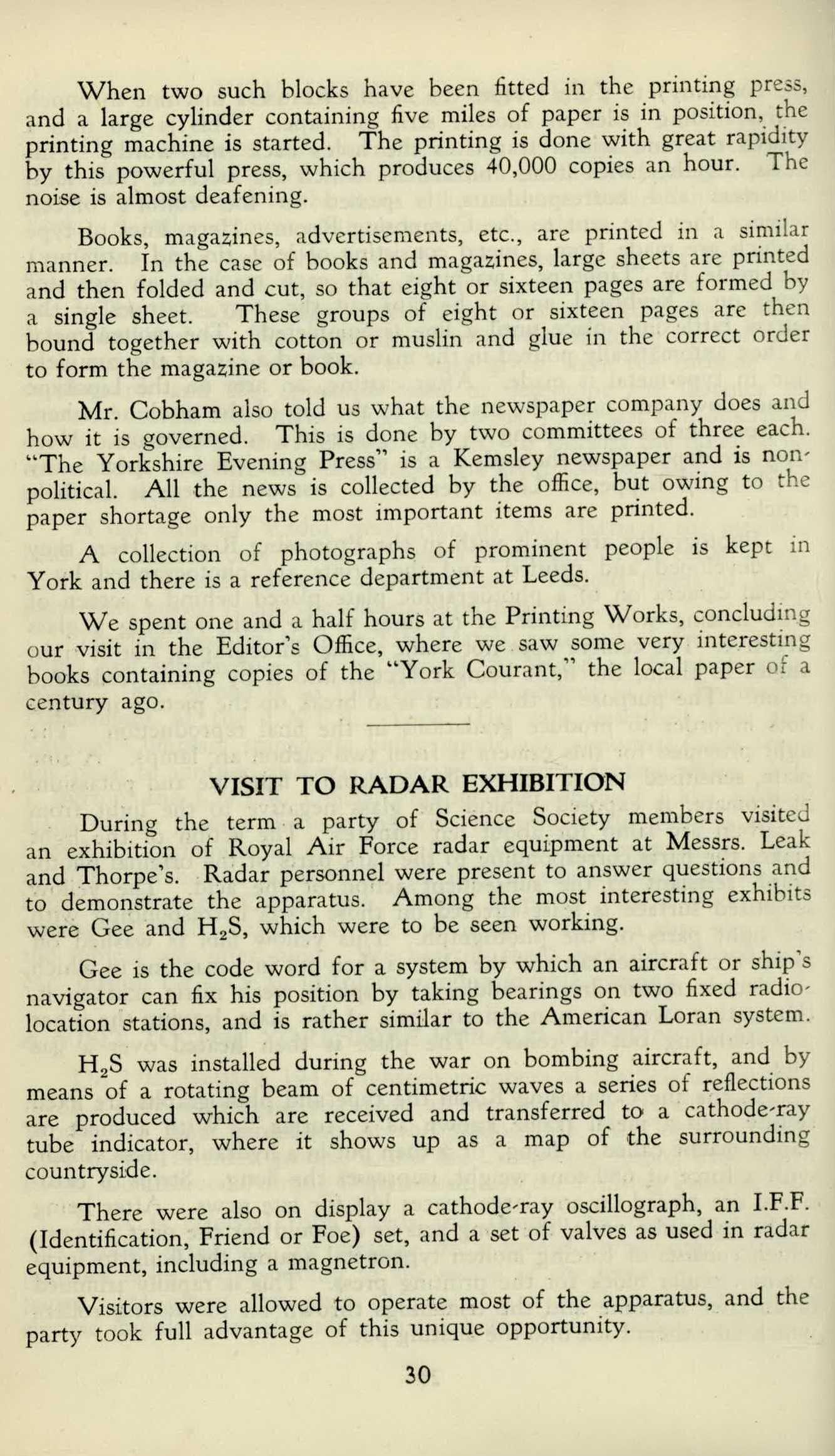
A VISIT TO COOKE, TROUGHTON & SIMMS' OPTICAL WORKS
Permission to visit their Lens Factory on Friday 7th February, was kindly given by Messrs. Cooke, Troughton & Simms, and accordingly the Middle Sixth physicists made good use of this opportunity and spent a most interesting and informative afternoon.
The factory was built in 1939, and during the war was engaged largely on secret work. The firm then had some 2,000 employees, but now the number has dwindled to about 800. The building is by no means void of activity, and it is in fact difficult to visualise how the other 1,200 could have been employed. The firm has another factory in York near Bishop's Hill, and yet another further away in London. The firm is well known for the exceedingly high quality of the instruments turned out.
At the moment the chief products of the factory are theodolites, naval range-finders, and miscroscopes of all types, ranging from the highly developed Vickers' projection miscroscope to ordinary school miscroscopes. The factory has its own forge where the parts for the different instruments are made, but it imports all its glass both for prism and lens making. It also has its own drawing office where the plans for all the instruments are designed and drawn.
The lenses and prisms, when they have been cut and moulded, are polished first of all with emery powder and then with ferric oxide, better known, perhaps, as "jewellers' rouge." During the war a new substance, cerium oxide, was used fairly extensively in place of the jewellers' rouge, but the latter is generally considered as being slightly the more efficient of the two. The size of the lenses ranged from the size of a pin-head to 3 ins. in diameter, and it was difficult to realise that the minute pieces of glass used for miscroscope objectives were indeed lenses. Objectives are corrected for chromatic and spherical aberration and the other defects common to optical instruments by a series of lenses through which the light is subsequently passed.
All the products of the factory have to be labelled with the name of the firm, and there is a special machine, incorporating a pantograph, which does this. Another instrument is used for marking the degrees of a circle on horizontal discs. The temperature of the room in which the instrument is kept is constant, for any slight change in temperature of a degree or two could cause an error in the marking at the finish of a revolution. Throughout the whole factory, perhaps the most impressive thing was the accuracy with which everything was executed. Using theodolites for surveying an area almost as large as England itself, the error incurred at the end of the survey may be of the order of only a few inches and seconds of arc. Where a uniform very thin line was required for use in certain optical instruments, spiders' threads were used. Men were sent up onto the moors to collect spiders of a certain type, which, after having been 31
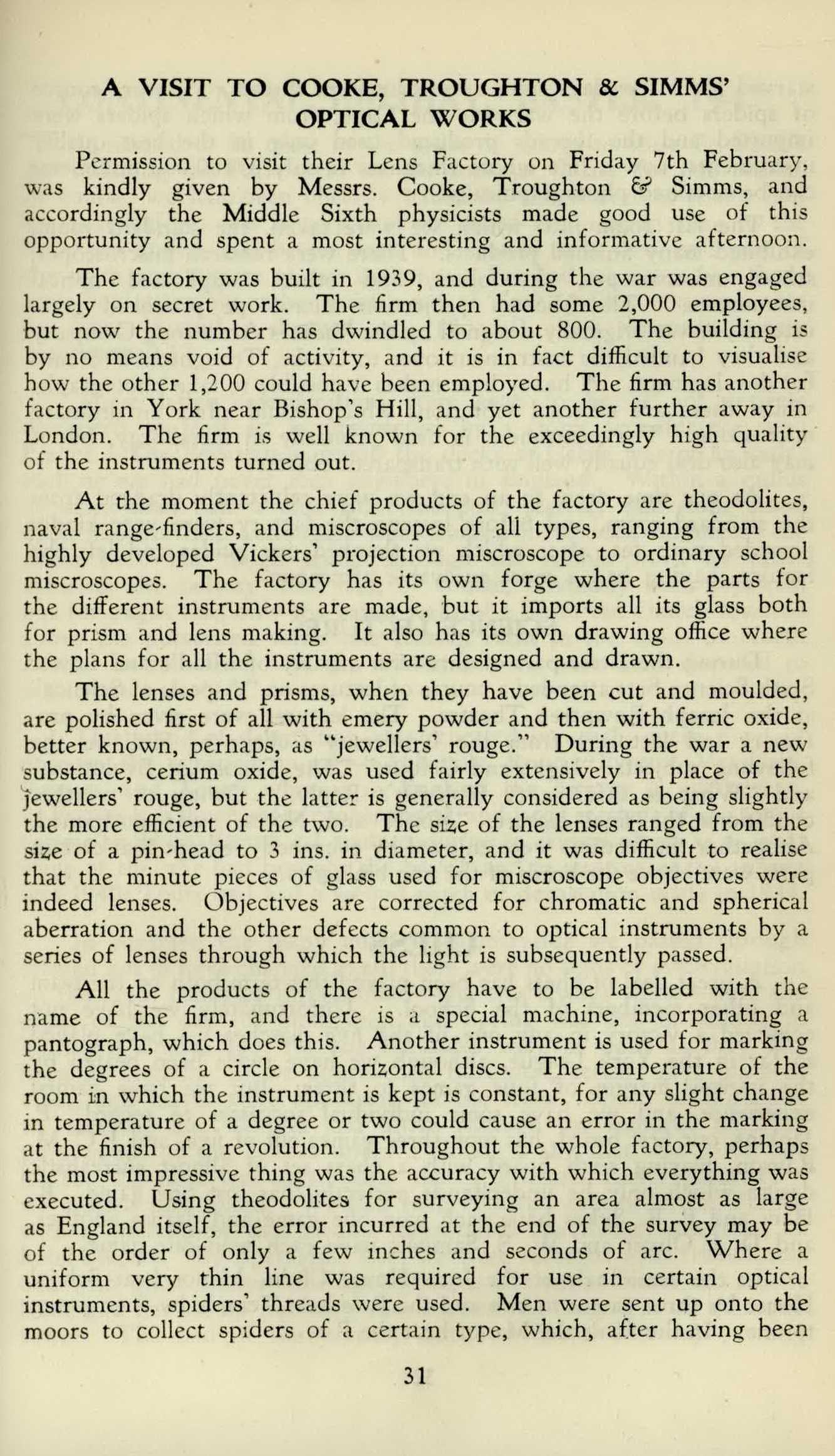
starved for a few days spun a very uniform thread. Another source of spiders before the war was the Cape, from which spiders were imported and the threads produced used only in the best quality instruments; now a line whose thickness is only 3/100,000 millimeter can be obtained photographically.
The last room into which we were taken, the standard room, exhibited many finished products. There were research miscroscopes, school miscroscopes, theodolites, and other complicated optical instruments. The Vickers' projection microscope provoked great interest, it was originally designed by the Vickers Armstrong Company and they handed the instrument over to Cooke, Troughton & Simms for development. A heavy base makes it possible to take photographs whilst there are external vibrations which would affect an ordinary microscope. The instrument is used primarily in metallurgy, but it may also deal equally well with transparent objects.
As our time drew to an end we were reluctantly dragged from the standard room, and before leaving the factory were very kindly provided with tea, after which we thanked our guides and left the factory, having had a most enjoyable afternoon.
SCIENCE LECTURES
During the latter part of this term a party of Middle and Lower Sixth Science Sets attended a course of lectures on "Aspects of Science" at the Joseph Rowntree Theatre. The lectures were given by professors and lecturers from the University College of Hull on the following subjects: "Light and Colour," "The Theory of Evolution," and "What is Life? A Biologist's Reply." Owing to weather conditions the final lecture, "Noises and Notes," was postponed. Altogether the lectures were enjoyed by everybody, except that certain parts were above the heads of the non-biologists.
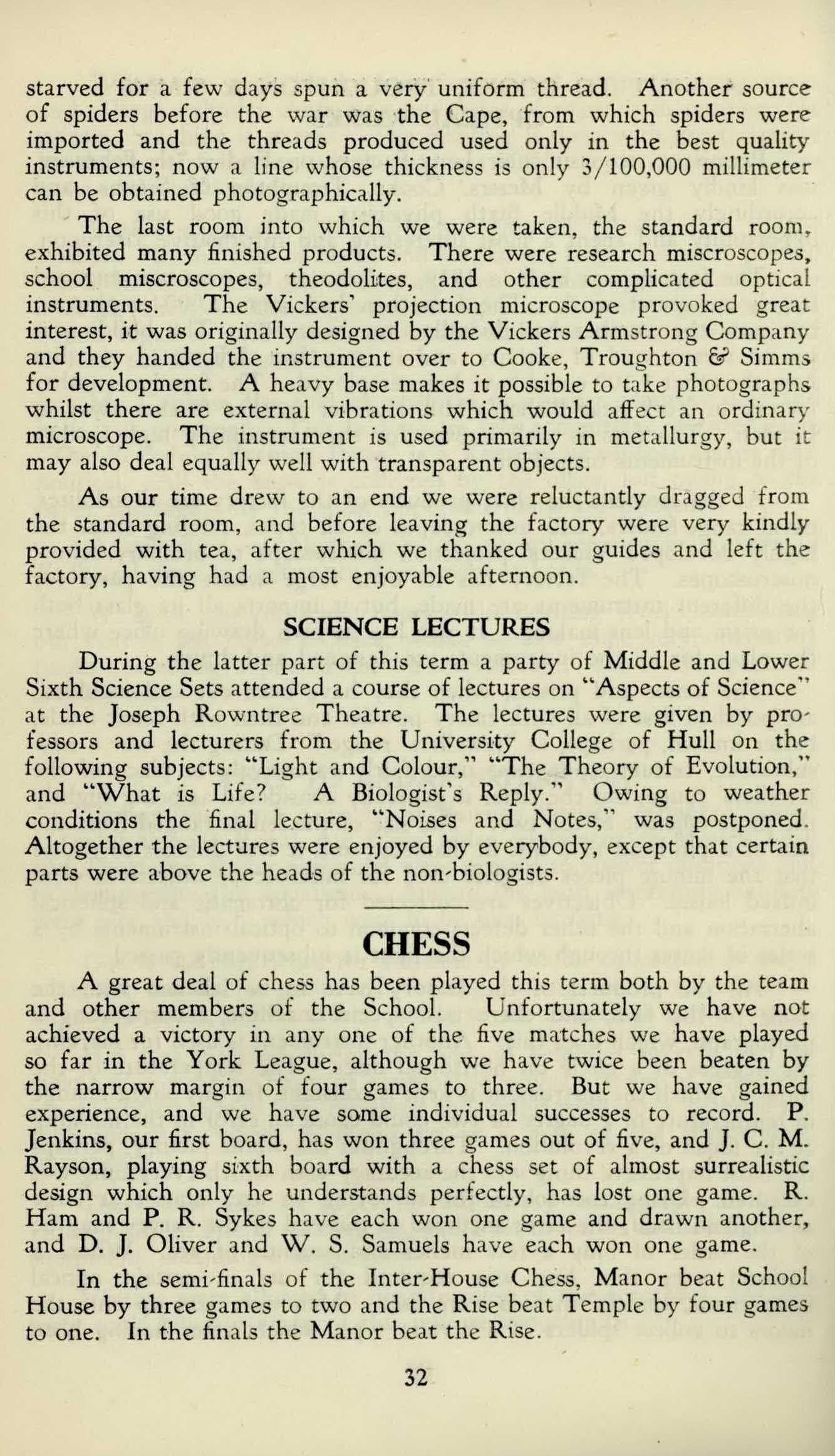
CHESS
A great deal of chess has been played this term both by the team and other members of the School. Unfortunately we have not achieved a victory in any one of the five matches we have played so far in the York League, although we have twice been beaten by the narrow margin of °four games to three. But we have gained experience, and we have some individual successes to record. P. Jenkins, our first board, has won three games out of five, and J. C. M. Rayson, playing sixth board with a chess set of almost surrealistic design which only he understands perfectly, has lost one game. R. Ham and P. R. Sykes have each won one game and drawn another, and D. J. Oliver and W. S. Samuels have each won one game.
In the semi-finals of the Inter-House Chess, Manor beat School House by three games to two and the Rise beat Temple by four games to one. In the finals the Manor beat the Rise.










